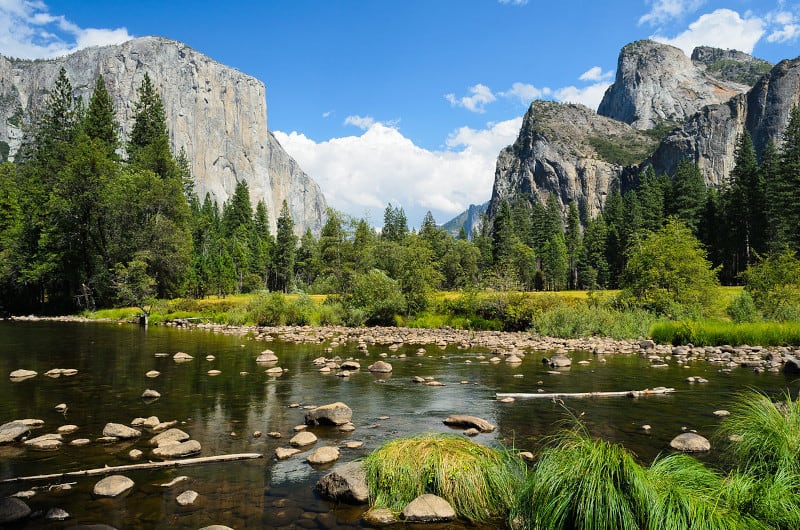
Yosemite Valley Facts
- This creation of time and natural processes, with its bountiful, spellbinding beauty bears the simple name of Yosemite Valley. It’s widely considered to be among the most magnficent of all natural marvels in the region of the world in which it formed.
- It’s not currently known exactly when ancient man first learned of its existence. Arcaeological evidence does indicate, however, a date at which ongoing habitation of the area began. Discoveries trace the beginning of that to roughly 3,000 years ago.
- Over that expanse of time, different groups of Indigenous Peoples populated the site. This presence remained ongoing at the time of the discovery of the site by non-native explorers. At that time, members of the Ahwahnechee tribe called the location home.
- Members of the Joseph Walker party likely constituted the first outsiders to view the valley. That group’s exploration of that part of the continent took through its immediate area. The first descriptions of it, though, did not occur until 20 years after that.
- Today, Yosemite Valley earns full appreciation for its splendor. Given that, it’s now listed as a National Historic District in its country. It represents the most prominent component of Yosemite National Park. As such, it enjoys a measure of protection.
- It also plays host to several individual features that are themselves works of natural art. These include Yosemite Falls and El Capitan. Though it now represents one of the largest tourist draws in its region, great care’s taken to maintain its pristince condition.
Related Articles
Yosemite Valley Physical Description
The magical Yosemite Valley distinguishes itself from many of the countless other similar features around the world. That’s because it captures the awe and imagination of the visitor in more than one way. As if its beauty wasn’t enough, it also boasts a respectable size.
The breathtaking formation runs for approximately 7.5 mi (12.1 km) in a general east-west direction. The valley also possesses impressive cliff walls along its length. These remarkable cliffs themselves reach heights ranging from about 3,000 – 3,500 ft (910 – 1,070 m).
Its width naturally varies across its length. It doesn’t do so to any significant degree, however. Overall, this equals roughly 1 mi (1.6 km). Meanwhile, the floor of the valley also boasts an impressive statistic. This aspect of it sits at 4,000 ft (1,200 m) above sea level.
More than a dozen creeks of varying sizes plunge over the bluffs, as well. These merge into the Merced River, which flows from the western end of the valley. This continues on the length of the canyon. From there, though, it flows into the San Jaoquin Valley.
Numerous individual features also fill Yosemite Valley. Here is one way it sets itself apart from many otherwise similar features across the earth. The waterfalls created by the flowing creeks aren’t the only ones. Forests and open meadows both fill portions of its area.
The lower end of the valley hosts the marvels of El Capitan, Cathedral Rocks, and Bridal Veil Falls. Just past this can be found the wonders of Sentinel Rock and the Cathedral Spires. The incredible Glacier Point also resides there, sitting 3,200 ft (980 m) above the valley floor.
Yosemite Falls Location, Formation, and Ecology
The location of the mesmerizing Yosemite Falls comes as no surprise to many who learn of it. That’s true since it formed in a section of the globe well known for its geological beauty. This masterpiece of Nature is in a section of what’s now the continent of North America.
More precisely, it lies within the national boundaries of the United States. There, it sits in the general northwest section of the country. That places it within the central part of the state of California. It also represents a part of the beautiful western Sierra Nevada Mountains.
The primary formative force behind its creation was continental uplift. In its case, the process began an estimated 114 million years ago. At that time, the pluton holding El Capitan pushed into the area. The youngest part of the valley emerged around 87 million years ago.
Over the last 30 million years, though, glaciers have been the driving force behind its present appearance. During that time, these periodically filled and then exited the site. The retreat of these carved many of the features seen now, due to their inexorable effects on the land.
Visually stunning Yosemite Valley also plays host to a vital, thriving ecosystem. The copious water supplied by the creeks and waterfalls provides for numerous species. This includes a fairly wide variety of flora, such as a multitude of tree, shrub, and wildflower species.
Many animals call the site home, as well. A few amphibians appear there, such as the Sierra Nevada Salamander. Mammals and birds also abound within its confines. Several small reptilian species do too, such as rattlesnakes, Gilbert’s Skink, and northern alligator lizard.
Features Sharing Its Region
Check out our other articles on Africa’s Many Geological Masterpieces, Tufted coquette, Victoria Falls, Grizzled Giant Squirrel, Santa Rosa Island Manzanita, Wolf Eel, Philippine Cobra
